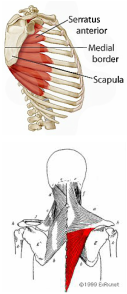 A conversation over on Facebook about warming up had me reviewing my post from waaaay back in February on warm ups. It reminded me that I was remiss in not emphasizing my love of working oppositional muscles to improve the balance of muscle pull on a joint. That means more pushing for all aerialists! Anyone who does that much pulling / hanging really should be doing some overhead pushing to balance out the muscles of the shoulder and surprise the stabilizers with forces in new directions. Acro / handbalancing / tumbler folks I recommend the exact opposite for you. How about giving hanging a try (with good form, please)? Overhead pulling is the answer for you. How should an aerialist get pushing? I'm a fan of training functional movements. So, how about a handstand (with good form, please)! Too hard? Try a downward dog. Somewhere between? Put your feet up on a increasingly higher supports, as you can maintain your shoulder control, until you are stacked and in an upside-down L shape with your hips over your hands. Don't forget! This is all about pushing, for you (wonderful) body nerds this is coming primarily from the serratus anterior. Keep your shoulder blades actively reaching away from your hips and your elbows feeling like they are rotating towards each other (as if you were trying to turn you thumbs to point forward from the shoulder). If you are a handbalancer working on pulling, hanging is all about proper form and getting the shoulder blades and humerus in the proper position. Your shoulder blade needs to rotate upward a full 60 degrees. Your serratus anterior is already super strong from all of your pushing. You'll be relying more on your lower trapezius to keep your scapula down on your back while helping with your scapula's upward rotation. Note the distinctions that these things should be done overhead. Our shoulder is a complex joint and the intricacies of the motion and stabilization of full shoulder flexion deserve and need extra love. For you body nerds check out this video, with a more full description of the movement and the movers at play coming soon.
0 Comments
Leave a Reply. |
Dr. Emily Scherb
|
 RSS Feed
RSS Feed